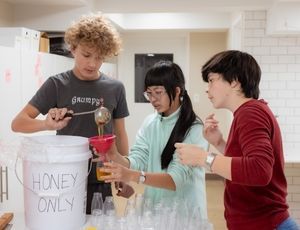Montessori Education – A Pathway to World Peace
An Introduction to Cultural Diversity and Inclusion
By Marcia Kidd
When Maria Montessori returned from India after World War II, she was asked to state her nationality. Rather than referring to her Italian citizenship, she responded,
I live in Heaven, my country is a star which turns around the Sun and is called the Earth (Montessori).
In her book Education and Peace , she went further to state that “we are a single organism” and that “contemporary man has citizenship in the great nation of humanity.” As technology and lightning fast communication make our world seem smaller and bring us ever closer to neighbors in other countries, we understand our global interdependence and are able to better appreciate the wisdom of Montessori’s words.
Montessori began with the study of physical geography – Earth, our most fundamental resource for survival. Three and four-year-olds are introduced to the Land and Water Globe, with its sandpaper land masses and smooth painted blue water. Students are then shown models of specific land and water forms: island/lake, peninsula/gulf, cape/bay, isthmus/strait, and archipelago/system of lakes. These concepts are made concrete by pouring water into the forms; children may then place a land animal on the island and an aquatic animal in the water. Soon a lesson follows to demonstrate that, though the Earth is a sphere, for practical reasons maps are drawn in two dimensions. Children continue to learn the names of Earth’s major land masses through lessons with the Continent Globe and the Continent Puzzle Map.

Political geography is first introduced by means of a Puzzle Map for each continent; each country is represented by its own puzzle piece. Picture Packets bring countries to life, giving the child a view of natural and manmade landmarks, indigenous plants and animals, how the people look and dress, their language, homes, schools, occupations, modes of transportation, the foods they eat, their artwork, music and cultural and religious celebrations. Children study the symbolism of the country’s flag, and teachers gather as many artifacts from the country as possible to share with students. Children delight in learning about the cultural celebrations of different countries, which are often presented by members of the school community.
At the Elementary levels, students focus increasingly on political geography, relating culture and history to how different groups meet what Montessori called their fundamental needs . She divided the Fundamental Human Needs into two categories: material needs (shelter, nutrition, clothing, transportation, protection/safety and communication) and spiritual needs (love, spirituality/religion, culture/arts/music, and self-adornment). Students are encouraged to reflect on the material provisions that are absolutely necessary for survival. They are then challenged to discover what humans need to feed their minds and souls, develop their potential and to be happy.
Relating the physical geography of a specific country to the manner in which its people meet their basic material and spiritual needs becomes a springboard for research into different cultures, both of today and past history. “The realization that all humans, across the ages and continents, share the same needs, can help to connect us, no matter what language we speak, or what religion [or belief system] we honor” (Baker). Understanding that we as humans are more alike than different helps students to lay the groundwork for a more peaceful world.
References:
Baker, Irene. “The Joy of Geography”. https://www.montessoriservices.com/ideas-insights/the-joy-of-geography
Baker, Irene. The Fundamental Needs of Humans”. https://www.montessoriservices.com/ideas-insights/the-fundamental-needs-of-humans






